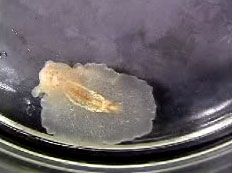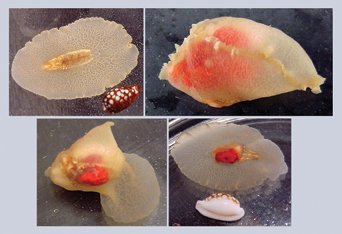Killer Flatworms Hunt with Poison
A newly discovered flatworm uses poison to hunt small, shelled sea creatures.
By Emily Sohn
Five years ago, marine biologist Raphael Ritson-Williams was collecting flatworms in the waters around the Pacific island of Guam, when he found a new species. He put the oval, filmy, yellow flatworm in a container for further study.
On the same collecting trip, Ritson-Williams picked up a type of shelled sea creature called a cowrie and put it in the same container with the flatworm. He planned to give the cowrie to a friend who was studying these mollusks.
 |
|
A flatworm eating a marine snail. |
| Proceedings of the National Academy of Sciences |
When he checked the container after a while, however, something had changed. The flatworm “was really fat,” Ritson-Williams says. And all that was left of the cowrie was an empty, speckled shell—and a mystery.
The silver-dollar-sized flatworm had eaten the mollusk, but it had no teeth or any other obvious weapons. Instead, as tests showed, the flatworm contained a poison called tetrodotoxin. It’s the same poison found in a number of other creatures, including puffer fish, several types of frogs, North America’s rough-skinned newt, the blue-ringed octopus, and some other flatworms.
Now, Ritson-Williams and his coworkers are trying to figure out how the flatworms use tetrodotoxin. In one experiment, the scientists watched flatworms kill at least 30 different species of mollusks, including ones with protective trap doors. The flatworms appear to enclose the shelled creatures with toxin-laced water.
 |
|
A newly discovered flatworm from Guam wraps its body around a cowrie in its shell, paralyzes it with a nerve toxin, and pulls out the cowrie’s red body in about half an hour and leaves the shell behind. |
| Ritson-Williams |
In another experiment to test the use of the toxin defensively, the researchers fed flatworms to wild fish. Many of the fish gobbled up the flatworms, and none seemed to get sick right away. This suggests that tetrodotoxin helps flatworms kill, but it doesn’t protect adult flatworms from being eaten.
The flatworm’s eggs have a lot of tetrodotoxin. Other researchers have suggested that the toxin might help defend the eggs, but Ritson-Williams hasn’t tested this idea yet.
Where the poison comes from is another mystery. Some scientists suggest that the flatworms get tetrodotoxin from bacteria that live inside them.—E. Sohn
Going Deeper:
Milius, Susan. 2006. Killer flatworm: New species hunts with puffer fish toxin. Science News 169(Feb. 18):100. Available at http://www.sciencenews.org/articles/20060218/fob3.asp .
You can see a movie of the killer flatworm in action at http://www.sciencenews.org/articles/20060218/worm.mov .
Sohn, Emily. 2004. Toxic birds may get poison from beetles. Science News for Kids (Nov. 10). Available at http://www.sciencenewsforkids.org/articles/20041110/Note2.asp .
______. 2004. Frogs get poison from ants. Science News for Kids (May 12). Available at http://www.sciencenewsforkids.org/articles/20040512/Note3.asp .
______. 2003. Frog chemist creates a deadlier poison. Science News for Kids (Sept. 10). Available at http://www.sciencenewsforkids.org/articles/20030910/Note3.asp .







